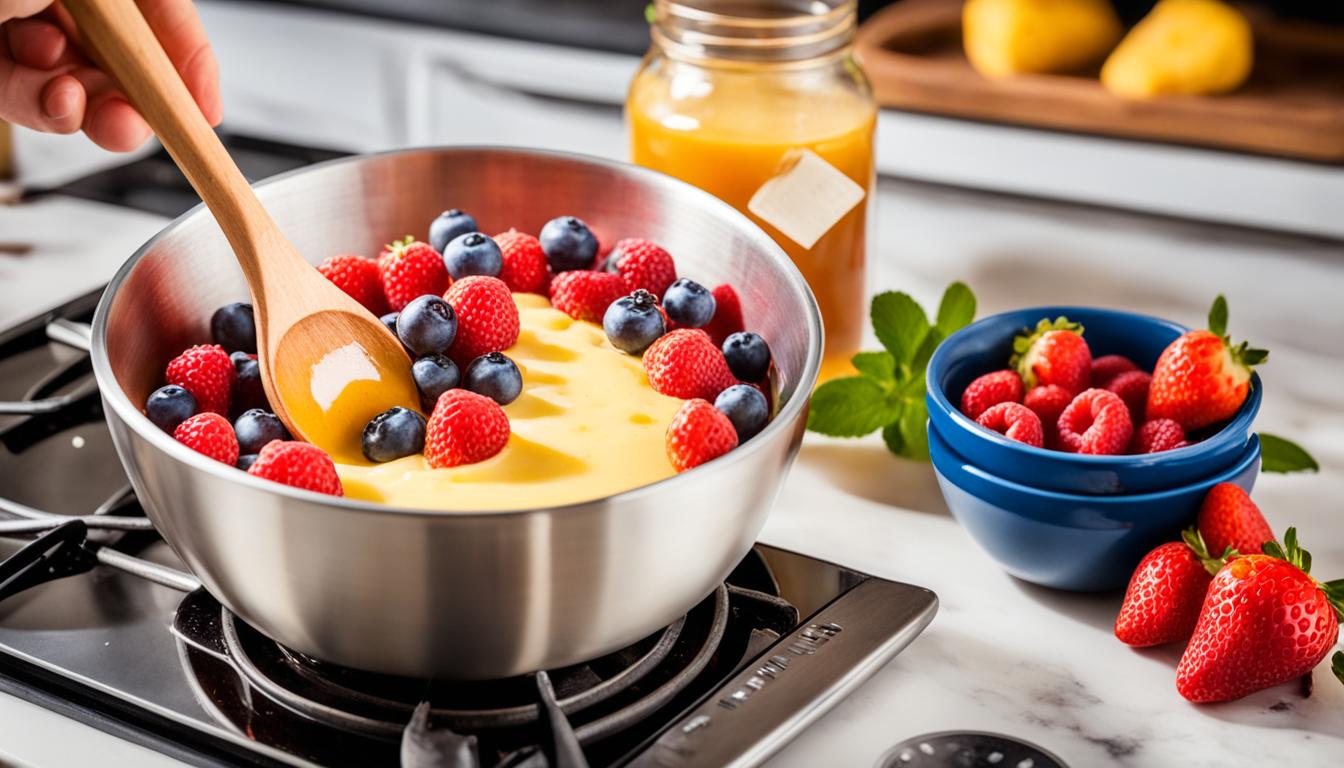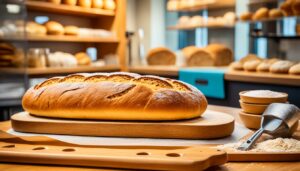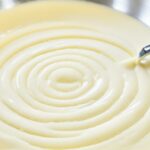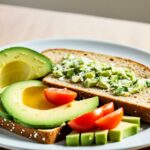Originally posted on March 26, 2024 @ 8:09 pm
Can honey replace sugar in a recipe? That’s the burning question on many bakers’ minds. While sugar has long been the go-to sweetener in recipes, the use of honey as a healthier alternative is gaining popularity. But is honey really a viable substitute for sugar in baking? And if so, how can you make the swap successfully?
In this article, we will dive into the world of honey and explore its potential as a sugar substitute in your favorite recipes. From the benefits of using honey in cooking to the techniques for substituting honey for sugar, we will uncover the secrets to achieving sweet, flavorful, and healthier baked goods. So put on your apron and get ready to discover the sweet possibilities of baking with honey!
Contents
- 1 The Health Benefits of Cutting Out Sugar
- 2 Why Honey Is a Healthful Alternative to Sugar
- 3 How to Substitute Honey for Sugar When Baking
- 4 How to Substitute Honey for Sugar in Liquids and Small Recipes
- 5 The Differences Between Honey and Sugar in Baking
- 6 The Best Types of Honey for Baking
- 7 Tips and Considerations for Substituting Honey for Sugar in Baking
- 8 Conclusion
- 9 FAQ
- 9.1 Can honey be used as a substitute for sugar in recipes?
- 9.2 What are the benefits of using honey instead of sugar?
- 9.3 How do I substitute honey for sugar when baking?
- 9.4 How do I substitute honey for sugar in liquids and small recipes?
- 9.5 What are the differences between honey and sugar in baking?
- 9.6 What are the best types of honey for baking?
- 9.7 What are some tips for substituting honey for sugar in baking?
- 9.8 Is it possible to eliminate sugar from my diet?
- 9.9 How can honey be used as a natural sweetener in cooking?
- 10 Source Links
Key Takeaways:
- Honey can be a natural and healthier alternative to sugar in recipes.
- Substituting honey for sugar offers benefits such as increased energy and better weight management.
- Proper techniques and measurements are crucial when swapping sugar for honey in baking.
- Choosing the right honey variety can enhance the flavor of your baked goods.
- Explore the sweet simplicity of using honey in your baking endeavors.
The Health Benefits of Cutting Out Sugar
Eliminating sugar from the diet can have numerous health benefits. The effects of sugar on the body can be detrimental, leading to various health issues such as inflammation and weight gain. By cutting out sugar and adopting a sugar-free lifestyle, individuals can experience positive changes in their overall well-being.
1. Reduced Inflammation: Sugar consumption has been linked to chronic inflammation, which is associated with a range of health conditions including heart disease, diabetes, and autoimmune disorders. By eliminating sugar from the diet, individuals can lower inflammation levels, leading to improved health and decreased risk of chronic diseases.
2. Improved Energy Levels: Sugar provides a quick energy boost but is often followed by a crash. By cutting out sugar, individuals can stabilize their blood sugar levels, resulting in sustained energy throughout the day. This can enhance productivity, mood, and overall well-being.
3. Promotes Weight Management: Sugar is high in calories and can contribute to weight gain. By eliminating or reducing sugar intake, individuals can better manage their weight and achieve their health goals. This is especially beneficial for individuals looking to lose weight or maintain a healthy weight.
4. Better Skin Health: Excessive sugar consumption can contribute to skin issues such as acne and premature aging. By cutting out sugar, individuals may experience improvements in their skin complexion and overall skin health.
5. Decreased Risk of Chronic Diseases: Sugar consumption has been linked to an increased risk of chronic diseases such as obesity, type 2 diabetes, and heart disease. By eliminating or reducing sugar intake, individuals can lower their risk of developing these diseases and improve their overall health.
| Health Benefits of Cutting Out Sugar |
|---|
| Reduced inflammation |
| Improved energy levels |
| Promotes weight management |
| Better skin health |
| Decreased risk of chronic diseases |
Reversing Inflammation with Sugar Reduction
“Cutting out sugar from your diet can have a significant impact on reducing inflammation in your body. By eliminating or reducing sugar intake, you can lower your risk of chronic diseases and improve your overall health.”
– Dr. Sarah Johnson, Nutrition Specialist
Why Honey Is a Healthful Alternative to Sugar
Honey is not only a delicious natural sweetener but also a healthful alternative to refined sugar. Let’s explore the numerous benefits of using honey instead of sugar and the advantages it brings to baking.
The Health Benefits of Using Honey
Unlike sugar, honey contains antioxidants, vitamins, and minerals that contribute to overall well-being. These natural components can support a healthy immune system, provide essential nutrients, and offer potential anti-inflammatory properties. By incorporating honey into your recipes, you can enjoy the sweet goodness while nourishing your body.
Enhanced Sweetness with Reduced Quantity
Honey is sweeter than sugar, which means you can use less of it to achieve the desired sweetness in your dishes. This reduction in quantity not only aids in weight management but also helps regulate blood sugar levels, making honey an attractive option for those with diabetes or those seeking to minimize sugar intake.
Unique Flavor Profile for Exceptional Taste
Baking with honey adds a distinctive flavor profile that enhances the overall taste of your creations. Depending on the type of honey used, you can enjoy floral, fruity, or robust flavor notes that add depth and complexity to your baked goods. The natural sweetness of honey complements a wide variety of recipes, from cookies and cakes to bread and muffins.
| Benefits of Using Honey Instead of Sugar: |
|---|
| Contains antioxidants, vitamins, and minerals |
| Reduces the amount of sweetener needed |
| Supports weight management and blood sugar regulation |
| Enhances the flavor profile of baked goods |
| Provides potential anti-inflammatory benefits |
With all these advantages, it’s clear why honey is a popular choice for health-conscious bakers. Whether you’re looking to reduce your sugar intake or enhance the taste of your recipes, incorporating honey as a natural sweetener offers a plethora of benefits.
Next, we’ll delve into the various techniques and considerations for successfully substituting honey for sugar in your favorite baking recipes. Stay tuned!
How to Substitute Honey for Sugar When Baking
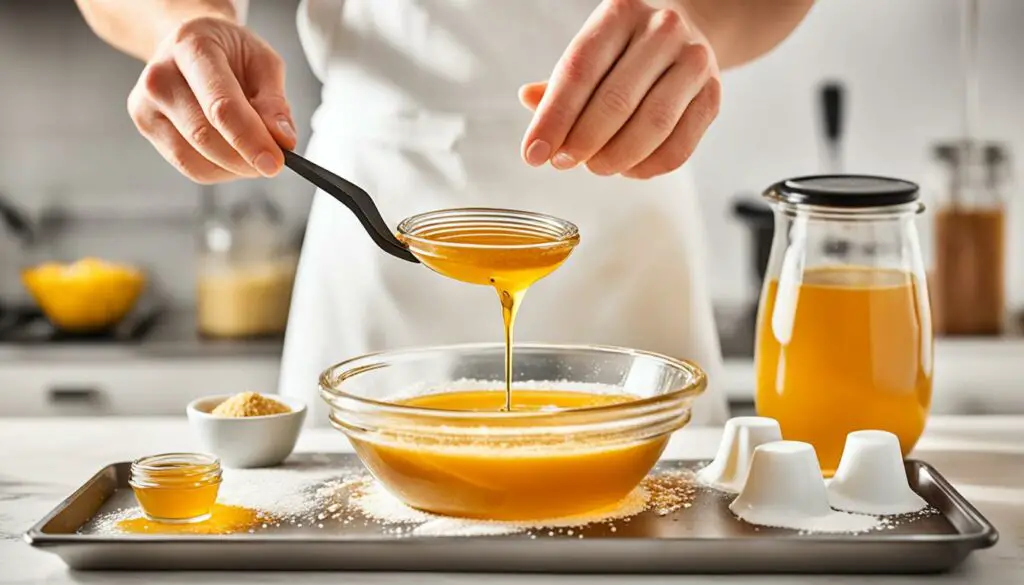
When it comes to substituting honey for sugar in baking, there are a few important factors to consider. Honey is sweeter and denser than sugar, so some adjustments need to be made to ensure the perfect balance of sweetness and texture in your baked goods.
To successfully replace sugar with honey in your recipes, follow these helpful tips:
- Adjust the quantity: When using honey as a substitute for sugar, you will typically need to use less honey than the amount of sugar called for in the recipe. As a general rule of thumb, use ½ to ⅔ cup of honey for every one cup of sugar. Adjust this ratio based on your personal taste preferences.
- Reduce other liquids: Since honey is a liquid sweetener with added moisture, it’s important to reduce the other liquids in your recipe to maintain the proper consistency. For every cup of honey used, decrease other liquids, such as milk or water, by ¼ cup.
- Lower the oven temperature: Honey tends to brown more quickly than sugar, so it’s crucial to lower the oven temperature by about 25 degrees Fahrenheit (14 degrees Celsius). This adjustment helps prevent over-browning and ensures even baking.
- Adjust the baking time: Due to the increased moisture content of honey, baking time may need to be slightly extended. Keep a close eye on your baked goods and use a toothpick or cake tester to determine when they’re fully cooked.
By following these tips, you can confidently substitute honey for sugar in your baking endeavors. Not only will you enjoy the natural sweetness and unique flavor profile of honey, but you’ll also benefit from its healthful properties.
For more specific conversion guidelines and useful insights, refer to the table below:
| Sugar | Honey |
|---|---|
| 1 teaspoon | 1/4 to 1/3 teaspoon |
| 1 tablespoon | 3/4 to 1 tablespoon |
| 1/2 cup | 1/3 to 1/2 cup |
| 1 cup | 1/2 to 2/3 cup |
Note: These conversion measurements are general guidelines. It’s always best to start with a smaller amount of honey and adjust to taste as needed.
Now that you know how to substitute honey for sugar when baking, you can confidently experiment with your favorite recipes and enjoy the delicious and healthful benefits of using honey as a natural sweetener. Get creative and discover a whole new world of flavors!
How to Substitute Honey for Sugar in Liquids and Small Recipes
When it comes to substituting honey for sugar in liquids and small recipes, a few key considerations can ensure a successful conversion. Whether you’re making sweet tea, lemonade, or even a mug cake, these tips will help you achieve the perfect balance of sweetness and flavor.
Substituting Honey for Sugar in Liquid Recipes
In liquid recipes such as sweet tea or lemonade, you can generally replace sugar with honey using a 1:1 ratio. This means that for every cup of sugar called for in the recipe, you can use an equal amount of honey. This simple substitution allows you to enjoy the natural sweetness of honey without compromising the taste of your favorite beverages.
If you prefer a milder honey flavor, you can combine honey with other sweeteners like maple syrup or stevia. This combination can help tone down the strong honey taste while still providing the desired level of sweetness. Feel free to experiment with different ratios until you find the perfect balance to suit your palate.
Replacing Sugar with Honey in Small Recipes
For small recipes like mug cakes, cookies, or other single-serving treats, it’s important to adjust the amount of honey used. Since honey is sweeter than sugar, using the exact same amount can result in an overly sweet final product.
As a general guideline, aim to use slightly more than ¾ of the amount of honey compared to sugar. For example, if a recipe calls for 1 cup of sugar, you can substitute it with roughly ¾ cup plus 2 tablespoons of honey. This adjustment will help maintain the desired sweetness while preventing your treats from becoming too sugary.
Remember to consider the overall sweetness level of your recipe and adjust the other ingredients accordingly. You might need to reduce the amount of other sweeteners or adjust the flavors to complement the natural taste of honey.
The Differences Between Honey and Sugar in Baking

When it comes to baking, honey and sugar have distinct differences that can significantly impact the outcome of your delicious creations. From texture and flavor to browning and consistency, understanding these differences is crucial for successfully substituting honey for sugar in your baking recipes.
Texture and Consistency
One of the most noticeable differences between honey and sugar lies in their texture and consistency. Honey is heavier, denser, and wetter compared to the granulated form of sugar. This can affect the overall texture of your baked goods, making them moister and denser when using honey. If you prefer lighter and fluffier results, you may need to make adjustments to other ingredients or techniques.
Flavor Profiles
The flavor of honey is another characteristic that sets it apart from sugar. While sugar provides a neutral sweetness, honey adds its distinct flavor profile to your baked treats. Depending on the type of honey used, it can impart floral, fruity, or even slightly tangy notes to your baked goods. Embracing the unique flavors of honey can enhance the taste experience, adding depth and complexity to your recipes.
Browning Properties
When it comes to browning properties, honey and sugar behave differently during the baking process. Honey tends to brown more quickly than sugar due to its moisture content. This means that you may need to adjust the oven temperature and baking time to prevent your baked goods from becoming overly browned or even burnt. Keeping a close eye on your creations is essential when using honey as a sugar substitute.
Summary of Differences Between Honey and Sugar in Baking:
| Honey | Sugar |
|---|---|
| Heavier, denser, and wetter | Granulated, dry |
| Distinct flavor profile | Neutral sweetness |
| Browns more quickly | Slower browning |
In summary, honey and sugar have their unique characteristics that impact baking outcomes. Honey’s texture, flavor, and browning properties differ from sugar, requiring adjustments in recipes. By understanding these differences, you can successfully substitute honey for sugar in your baking endeavors, creating delightful treats with its distinctive qualities.
The Best Types of Honey for Baking
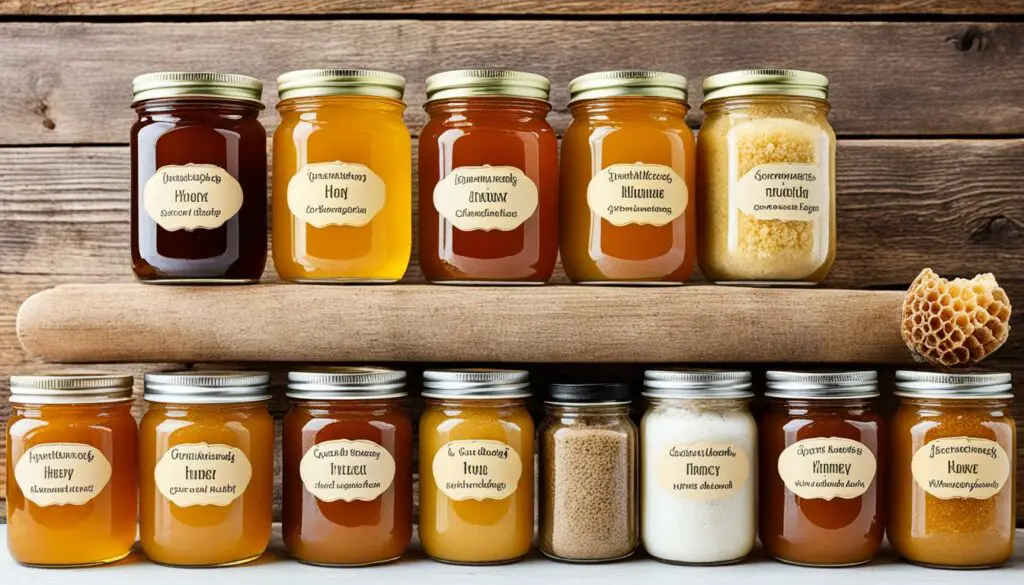
Not all honey varieties are created equal when it comes to baking. The right choice can make a significant difference in the taste and overall outcome of your baked goods. Here are some of the best types of honey for baking:
Clover Honey
Clover honey is a light and mild variety that is widely available. Its delicate flavor and light color make it a great choice for baking, as it won’t overpower the flavors of other ingredients.
Alfalfa Honey
Alfalfa honey, another light-colored option, has a subtle floral taste. It pairs well with a variety of flavors and is especially delicious in homemade bread or oatmeal cookies.
Sourwood Honey
If you’re looking to add unique flavors to your desserts or bread recipes, sourwood honey is an excellent choice. It has a rich, caramel-like taste with hints of spice.
Amber Honey
Amber honey offers a slightly stronger flavor profile, making it perfect for recipes that require a bolder taste. Its deep color and robust flavor can enhance the overall complexity of your baked goods.
Buckwheat Honey
Dark and robust, buckwheat honey adds a distinct earthy flavor to desserts. It pairs exceptionally well with dark chocolate and spices, creating a rich and indulgent taste.
Avocado Honey
Avocado honey is another darker variety that is known for its strong flavor. Its unique taste complements dark-colored desserts, such as gingerbread or molasses cookies.
By choosing the right honey variety for your recipes, you can enhance the taste and create a truly delightful baking experience.
Recommended Honey Varieties for Baking
| Honey Variety | Flavor Profile | Best for |
|---|---|---|
| Clover Honey | Mild, delicate | Baking with light flavors |
| Alfalfa Honey | Subtle floral | Bread, oatmeal cookies |
| Sourwood Honey | Caramel-like with hints of spice | Desserts, bread recipes |
| Amber Honey | Deep, robust | Recipes requiring bold flavor |
| Buckwheat Honey | Earthy, rich | Dark chocolate, spices |
| Avocado Honey | Strong, unique | Dark-colored desserts |
Tips and Considerations for Substituting Honey for Sugar in Baking
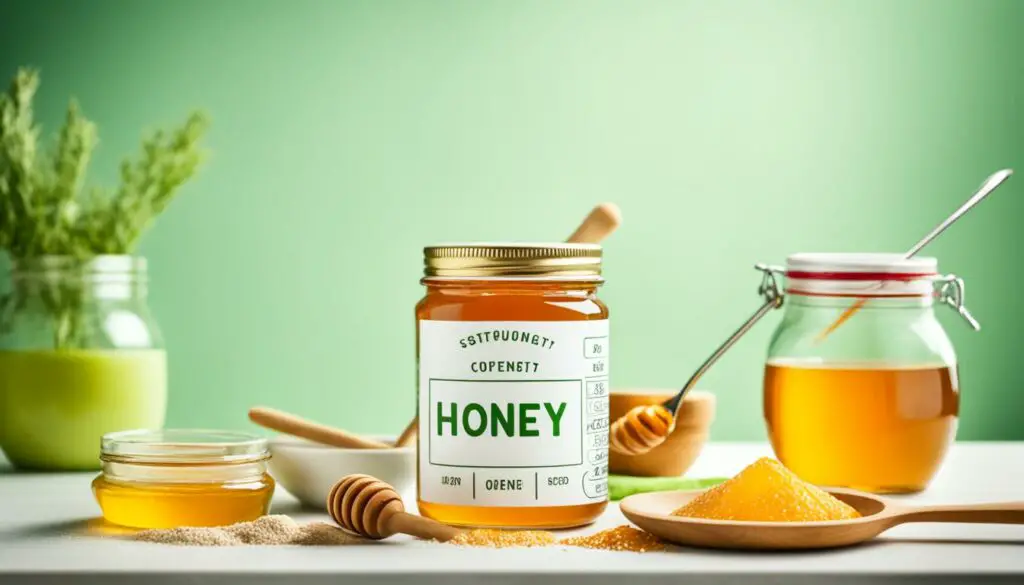
When it comes to substituting honey for sugar in baking, there are a few tips and considerations that can help you achieve successful results. Whether you’re looking to reduce your sugar intake, enjoy the health benefits of honey, or simply explore new flavors in your baked goods, these tips will guide you in using honey as a sweet and natural substitute.
Accurate Measurement is Key
Unlike sugar, honey is sticky and challenging to measure with traditional measuring cups. To ensure accurate measurements, use a digital scale to weigh the honey. By measuring the honey precisely, you can maintain the correct balance of sweetness and moisture in your recipes.
Adjusting the Sweetness Level
Honey is sweeter than sugar, so it’s essential to adjust the sweetness level when swapping sugar for honey. As a general guideline, use 30% less honey than the amount of sugar called for in the recipe. By reducing the honey quantity, you can prevent your baked goods from becoming overly sweet and maintain the desired taste profile.
Balancing Acidity with Baking Soda
It’s important to note that honey is acidic. To balance the acidity and ensure proper rising, adding a small amount of baking soda to your recipes is recommended. Baking soda helps neutralize the acidity of honey and promotes better texture and consistency in your baked goods.
Preventing Burning and Achieving the Perfect Texture
When baking with honey, it’s important to make a few adjustments to prevent burning and achieve the desired texture. Lower the oven temperature by 25°F (about 14°C) to prevent your baked goods from browning too quickly. Additionally, you may need to increase the baking time slightly to compensate for the increased moisture content of honey. These adjustments will help you avoid burnt edges and achieve a moist, tender texture.
By keeping these tips and considerations in mind, you can confidently substitute honey for sugar in your baking endeavors. Whether you’re making cookies, muffins, or cakes, experimenting with honey as a natural sweetener will add a touch of sweetness and unique flavor to your favorite recipes. Enjoy the goodness of honey in your baked goods while reaping the benefits of using a healthier alternative to sugar.
Conclusion
In conclusion, substituting honey for sugar in baking recipes is a smart choice that brings numerous benefits to your desserts. Not only does honey provide natural sweetness, but it also offers health advantages and unique flavors. By following the proper guidelines and making necessary adjustments, you can successfully incorporate honey into your favorite baked goods.
Experimenting with different honey varieties can enhance the taste and aroma of your treats. Light and mild varieties like clover honey or alfalfa honey are great choices for maintaining balance with other ingredients. Meanwhile, darker and stronger-flavored options such as sourwood honey or buckwheat honey can add complexity to desserts that call for bolder flavors. With these variations, you can create an array of delicious and unique baked goods.
Say goodbye to the negative effects of refined sugar by embracing the natural goodness of honey in your baking adventures. Not only will you enjoy delightful sweets, but you’ll also experience the health benefits associated with reducing sugar consumption. Substitute honey for sugar, follow the recommended measurements, adjust other ingredients accordingly, and savor the sweet simplicity of using honey in your recipes.
FAQ
Can honey be used as a substitute for sugar in recipes?
Yes, honey can be used as a natural and healthier alternative to sugar in recipes.
What are the benefits of using honey instead of sugar?
Honey offers several advantages over refined sugar, including increased energy, better mood, and improved weight management. It also contains antioxidants, vitamins, and minerals that can support overall health.
How do I substitute honey for sugar when baking?
When substituting honey for sugar in baking, you will need to adjust the quantities and other ingredients in your recipe. Use ½ to ⅔ cup of honey for every one cup of sugar called for in the recipe and reduce the other liquids. You should also lower the oven temperature and adjust the baking time.
How do I substitute honey for sugar in liquids and small recipes?
For liquid recipes, you can generally use a 1:1 ratio of honey to sugar. For small recipes like mug cakes, use slightly more than ¾ of the amount of honey compared to sugar. Adjust the sweetness level and other ingredients accordingly.
What are the differences between honey and sugar in baking?
Honey is sweeter, heavier, denser, and wetter than sugar, which can affect the texture and consistency of baked goods. Honey also has a stronger flavor and different browning properties. It may be necessary to adjust the oven temperature and baking time when using honey.
What are the best types of honey for baking?
Light and mild honey varieties, such as clover and alfalfa honey, are generally the best choice for baking as they have a light color and mild flavor. Sourwood and amber honey can add unique flavors, while darker varieties like buckwheat and avocado honey are perfect for dark-colored desserts.
What are some tips for substituting honey for sugar in baking?
Measure honey accurately using a digital scale, use 30% less honey as it is sweeter than sugar, add a small amount of baking soda to balance the acidity of honey, lower the oven temperature, and increase the baking time to prevent burning and achieve the desired texture.
Is it possible to eliminate sugar from my diet?
Yes, eliminating sugar from the diet can have numerous health benefits, including reducing inflammation, improving energy levels, and promoting better weight management.
How can honey be used as a natural sweetener in cooking?
Honey can be used as a natural sweetener in cooking by substituting it for sugar in recipes. It provides a natural alternative to refined sugar and adds a unique flavor profile to dishes.

